Breaking Free |
||||||||||||||||
 |
 |
|||||||||||||||
Crocheted jumper in DROPS Sky and DROPS Kid-Silk. The piece is worked top down with raglan and loop cables. Sizes XS - XXL.
DROPS 217-6 |
||||||||||||||||
|
------------------------------------------------------- EXPLANATIONS FOR THE PATTERN: ------------------------------------------------------- CHAIN STITCH: If you work outermost on the hook the chain stitch will often be too tight; 1 chain stitch should be as long as 1 treble crochet is wide. CROCHET INFORMATION: At the beginning of each row/round of treble crochets work 3 chain stitches; these chain stitches replace the first treble crochet, i.e. skip the first treble crochet from the previous row/round. The round ends with 1 slip stitch in the 3rd chain stitch at the beginning of the round. PATTERN: See diagrams A.1 to A.3. Choose diagram for your size (applies to A.2). INCREASE TIP (evenly spaced): To work out how to increase evenly, count the total number of stitches on the row (e.g. 66 stitches) and divide by the number of increases to be made (e.g. 8) = 8.2. In this example, increase by working 2 treble crochets in approx. each 8th treble crochet. RAGLAN: Increase 2 treble crochets by working 3 treble crochets in the first and the last treble crochet in A.3. The increased stitches are worked in treble crochets on the sleeves and in pattern on the front and back pieces as follows: Work the new stitches into A.2. There will always be 7-7-7-8-8-8 treble crochets between the vertical lines of chain-stitch loops (chain-stitch loops are worked into loop cables later). When there are 8-8-8-10-10-10 vertical lines with chain-stitch loops, work the remaining increased stitches in treble crochets. DECREASE TIP (for sleeves): Decrease 1 treble crochet on each side of the marker thread as follows: NOTE! Be aware that the marker thread is placed in transition between rounds, so that the decrease after the marker thread will occur on next round. Work until there are 4 treble crochets left before the marker thread, * make 1 yarn over, insert the hook through the next stitch, pick up the strand, make 1 yarn over and pull it through the first 2 loops on the hook *, work from *-* a total of 2 times, make 1 yarn over and pull it through all 3 loops on the hook (= 1 stitch decreased), work 4 treble crochets as before (the marker thread sits in the middle of these 4 stitches). Decrease 1 stitch in the same way after the marker thread. ------------------------------------------------------- START THE PIECE HERE: ------------------------------------------------------- JUMPER – SHORT OVERVIEW OF THE PIECE: The neck and yoke are worked in the round, from the side of the back piece and top down. The yoke is divided for the body and sleeves, which are then finished separately. NECK: Work 66-66-70-72-76-80 chain stitches – read CHAIN STITCH, with hook size 5 mm and 1 strand Sky + 1 strand Kid-Silk (= 2 strands). Form them into a ring with 1 slip stitch in the first chain stitch. Work 1 treble crochet in each chain stitch – read CROCHET INFORMATION. Then work A.1 in the round. When A.1 has been completed in height, work a round of treble crochets where you increase 8-8-8-12-12-8 treble crochets evenly spaced – read INCREASE TIP = 74-74-78-84-88-88 treble crochets. Insert a marker at the beginning of the round; the yoke is measured from this marker! YOKE: REMEMBER THE CROCHET TENSION! Now work pattern as follows: Work A.2 over the first 21-21-21-24-24-24 stitches (= 3 repeats) – remember CROCHET INFORMATION, work the first 4-4-4-4-4-4 symbols in A.2, i.e. 1 treble crochet + 10 chain stitches + 2 treble crochets (= back piece), work A.3 over the next 2 treble crochets (= raglan), work 1 treble crochet in each of the next 8-8-10-10-12-12 treble crochets (= sleeve), work A.3 over the next 2 treble crochets (= raglan), work 1 treble crochet in the next treble crochet, A.2 over the next 21-21-21-24-24-24 stitches (= 3 repeats), work the first 4-4-4-4-4-4 symbols in A.2, i.e. 1 treble crochet + 10 chain stitches + 2 treble crochets (= front piece), work A.3 over the next 2 treble crochets (= raglan), work 1 treble crochet in each of the next 8-8-10-10-12-12 treble crochets (= sleeve), A.3 over the next 2 treble crochets (= raglan) and 1 treble crochet in the last treble crochet on the round. Continue this pattern in the round; at the same time, on the next round, begin to increase to RAGLAN – read description above. Increase like this every round 1-2-3-3-4-4 times, every 2nd round 3-3-3-3-4-5 times and then every 3rd round 3-3-3-3-3-3 times = 186-202-222-228-264-280 stitches. Continue working until the yoke measures 20-20-22-23-26-28 cm from the marker on the neck. Now work the chain-stitch loops in A.3 together to make loop cables as follows: Insert the hook down the first chain-stitch loop at the top of the neck, from the right side, pull the 2nd chain-stitch loop through the first chain-stitch loop, insert the hook down the 2nd chain-stitch loop and pull the 3rd chain-stitch loop through the 2nd chain-stitch loop. Continue like this until all the chain-stitch loops have been worked together. Repeat on all A.3 sections on the round. You can thread a strand through the last chain-stitch loop if necessary, to prevent the cable from ravelling. The chain-stitch loops on the body are worked together in the same way later. On the next round, work as follows; the chain-stitch loops in A.2 and A.3 are not counted in the stitch numbers - work 1 double crochet in the last chain-stitch loop in A.3 to prevent the cable from ravelling (then skip this double crochet; it is not counted in the stitch count): Work pattern as before over the first 39-41-43-46-50-53 stitches, work 6-6-8-8-10-10 loose chain stitches (= in side under sleeve), skip the next 38-42-48-48-58-60 treble crochets (= sleeve), work pattern as before over the next 55-59-63-66-74-80 stitches (= front piece), work 6-6-8-8-10-10 loose chain stitches (= in side under sleeve), skip the next 38-42-48-48-58-60 treble crochets (= sleeve), work pattern as before over the remaining 16-18-20-20-24-27 treble crochets. Cut the strand. Body and sleeves are finished separately. BODY: = 124-132-144-150-170-182 treble crochets (+ chain-stitch loops). Insert a marker in the middle of the 6-6-8-8-10-10 stitches cast on under one of the sleeves. Fasten the strand with 1 slip stitch in the chain stitch after the marker and work 3 chain stitches (= 1 treble crochet) – remember CROCHET INFORMATION. Work pattern in the round as before, i.e. work treble crochets and chain-stitch loops as before over the chain-stitch loops on the front and back pieces. Work like this until the body measures 24-26-26-27-26-26 cm from the division. Now work the chain-stitch loops together in the same way as on the yoke. When all the loops have been cabled together, work the next round as follows: Work 1 treble crochet in each treble crochet, but at the end of each chain-stitch cable work 1 double crochet to prevent the cables from ravelling. Now work an edge as follows: Work A.1 the whole round. Repeat the last row in the diagram until the edge measures 5 cm. Cut and fasten the strand. The jumper measures approx. 52-54-56-58-60-62 cm from the shoulder down. SLEEVE: Insert a marker thread in the middle of the 6-6-8-8-10-10 chain stitches under the sleeve (= beginning of the round). Allow the thread to follow your work onwards. Fasten the strand with 1 slip stitch in the stitch after the marker thread and work 3 chain stitches (= 1 treble crochet) – remember CROCHET INFORMATION, then work 1 treble crochet in each of the next 2-2-3-3-4-4 chain stitches, 2 treble crochets around the next treble crochet (= in the corner between the chain stitches and the skipped treble crochets), work 1 treble crochet in each of these 38-42-48-48-58-60 treble crochets, 2 treble crochets around the next treble crochet (= in the corner between the chain stitches and the skipped treble crochets), work 1 treble crochet in each of the last 3-3-4-4-5-5 chain stitches = 48-52-60-60-72-74 treble crochets. Continue in the round with 1 treble crochet in each treble crochet. When the sleeve measures 3 cm from the division, start to decrease under the sleeve – read DECREASE TIP. Decrease like this every round 0-0-1-3-10-10 times and then every 2nd round 4-5-7-5-3-3 times = 40-42-44-44-46-48 stitches. Continue working until the sleeve measures 33-34-32-32-29-27cm from the division. Now work an edge as follows: Work A.1 the whole round. When the diagram has been completed in height, repeat the last row in the diagram until the edge measures 5 cm. Cut and fasten the strand. Work the other sleeve in the same way. |
||||||||||||||||
Diagram explanations |
||||||||||||||||
|
||||||||||||||||

|
||||||||||||||||

|
||||||||||||||||
|
Have you made this or any other of our designs? Tag your pictures in social media with #dropsdesign so we can see them! Do you need help with this pattern?You'll find tutorial videos, a Comments/Questions area and more by visiting the pattern on garnstudio.com. © 1982-2024 DROPS Design A/S. We reserve all rights. This document, including all its sub-sections, has copyrights. Read more about what you can do with our patterns at the bottom of each pattern on our site. |
||||||||||||||||












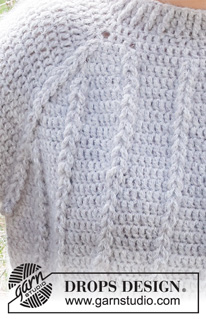











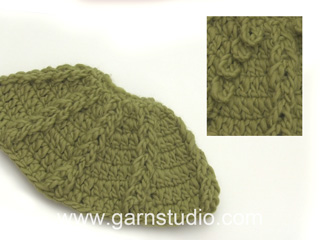
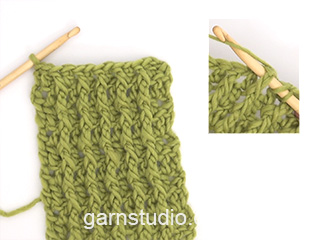

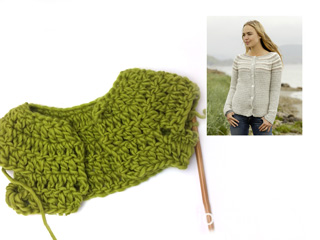



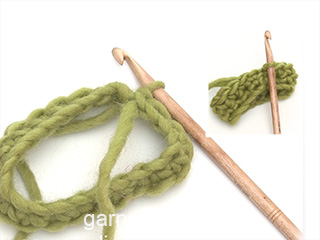


























Comments / Questions (24)
Hallo, der Pullover verzieht sich bei mir in die Häkelrichtung, kann man dagegen etwas tun? Vielen Dank
09.12.2023 - 01:25DROPS Design answered:
Liebe Evelyn, Sie können mal in Hin- und Rückreihen häkeln, am Ende jeder Reihe mit 1 Wettmache enden (wie in Runden) aber dann wenden und abwechslungsweise bei der Vorderseite und bei der Innenseite häkeln. Viel Spaß beim häkeln!
11.12.2023 - 07:44Hallo, ich versuche gerade diesen Pullover in Größe M zu häkeln. Allerdings brauche ich 80 Maschen an der Blende, damit ich es über meinen Kopf ziehen kann. Wie kann ich nun vorgehen, dass ich eine passende Blende habe, aber nicht gleichzeitig einen viel zu großen restlichen Pullover? Muss ich an einer Stelle Maschen abnehmen oder an anderer weniger/keine zunehmen? Aber wenn ja, wo? Vielen Dank im Voraus und liebe Grüße.
18.10.2023 - 22:22DROPS Design answered:
Liebe Amelie, damit die fertigen Maßnahmen für Ihre Größe stimmen die in der Maßskizze soll Ihre Maschenprobe stimmen, dh Sie sollen 14,5 Stäbchen x 8,5 Reihe = 10 x 10 cm haben. Hier lesen Sie mehr über die Maschenprobe - sollte sie verschieden sein, dann sollen Sie die ganze Anleitung nach Ihrer eigenen Maschenprobe neu umrechnen. Viel Spaß beim häkeln!
19.10.2023 - 08:10Bonjour, ce chandail a des coutures. Donc, la différence avec un modèle Raglan c'est juste que c'est plus vite à faire. Ou bien, il y a d'autres différences? Je n'ai pas encore décider et comme 1er modèle je pensais que le Raglan est plus facile, est-ce bien le cas?, merci. Marie
08.11.2021 - 16:32DROPS Design answered:
Bonjour Marie, ce modèle n'a aucune couture à faire, il se crochète de haut en bas en divisant l'ouvrage pour les manches à la fin de l'empiècement pour terminer chaque partie (bas du pull puis manches) séparément. Vous pouvez demander l'avis d'autres crocheteuses dans notre DROPS Workshop. Bon crochet!
09.11.2021 - 11:57Hej igen Jeg har haft skrevet og fået svar, men jeg synes fortsat ikke at jeg forstår opskriften. Hvis jeg øger med 7x16 som I skriver, svarer det jo til 7 runder hvor jeg tager 16 masker ud på hver runde - det passer med raglan. Men så øger jeg fortsat ikke med de andre udtagninger. Jeg synes jo regnestykket vil se sådan ud (i str. S): 74 + (16+2)+(16+3)+(16+3)+(16+2)+(16+3)+(16+3)+(16+2)= 204, men det passer ikke med de 202 ??
16.09.2021 - 12:12DROPS Design answered:
Hej Mette. Det är kun maskorna till raglan du ska öka som vi förklarade i tidigare svar. Mvh DROPS Design
22.09.2021 - 09:01Kan I uddybe maskeantallet på hver runde ved bærestykket, når der udtages til raglan? Jeg hækler str S og jeg kan kun få maskeantallet til at passe, hvis jeg tager ud til raglan UDEN at tage 2-3-3 masker ud yderligere?!
07.09.2021 - 23:11DROPS Design answered:
Hei Mette. Vi har dessverre ikke muligheten til å tilføye maskeantallet etter hver økning i alle størrelser i oppskriften. I str. S har du 74 masker og du øker med 16 masker hver gang det økes til raglan. I str S økes det 1 gang på hver omgang, deretter på hver 2. omgang 3 ganger, og så på hver 3. omgang 3 ganger. Altså du har økt på 7 omganger (1+3+3) og på hver økeomgang øker du med 16 masker = 7x16= 112 økte masker + de 74 maskene du hadde i begynnelsen = 186 masker. mvh DROPS design
15.09.2021 - 13:53Opskrift drops 217-6 Raglan : der står: Tag 2 stgm ud ved at hækle 3 stgm i den første og sidste stgm i A 3. . ? så er der jo taget 4 stgm ud ? Mvh. Anne Lise
21.08.2021 - 11:03DROPS Design answered:
Hei Anne Lise. Jeg skjønner tankegangen din, men her er det ment at det skal økes med 2 masker i hver maske det økes. Altså når du hekler A.3 økes det med 2 masker i den første masken og det økes med 2 masker i den siste masken. mvh DROPS design
27.08.2021 - 09:47Hallo guten Tag, ich komme bei der Anleitung nicht weiter. Hier steht: 1Stb in jede der 3-3 nächsten fM,dann 2 Stb in die nächste Masche. Bitte was heißt 3-3? Vielen Dank für die Antwort
11.06.2021 - 21:37DROPS Design answered:
Liebe Dagmar, jedes "3" steht für eine Größe, bei der Ärmeln beginnen Sie die Runde in die Luftmasche nach der Markierungsfaden und häkeln Sie 3 Lm, dann 3 Stb (= in 3. + 4. Größe = je 1 Stb in die nächsten 3 Lm), und enden Sie die Runde mit je 1 Stb in die letzten 4 Luftmaschen der Runde. Kann das Ihnen weiterhelfen?
14.06.2021 - 07:58Kan ik deze trui ook met haaknaald drie en halfhaken
25.03.2021 - 15:51DROPS Design answered:
Dag Dina,
Bij de stekenverhouding staat aangegeven hoeveel steken je moet hebben op 10 x 10 cm. Hierop moet je de dikte van de haaknaald aanpassen. Maak eerst een proeflapje met de aangegeven naalddikte in het patroon. Als je te weinig steken hebt op 10 cm, neem dan een kleinere haaknaald, als je te veel hebt een grotere. Maak opnieuw een proeflapje tot je de juiste stekenverhouding hebt.
26.03.2021 - 15:42Kan ik deze trui ook met driehalf haken
25.03.2021 - 15:48Kan man mon finde opskriften skrevet ‘normalt’ og ikke i diagram?:)
18.02.2021 - 06:58DROPS Design answered:
Hej Julie, vi laver diagrammer til alle vores opskrifter med mønster. Men der findes også altid en video som viser hvordan man gør. Se nederst i opskriften :)
18.02.2021 - 08:34